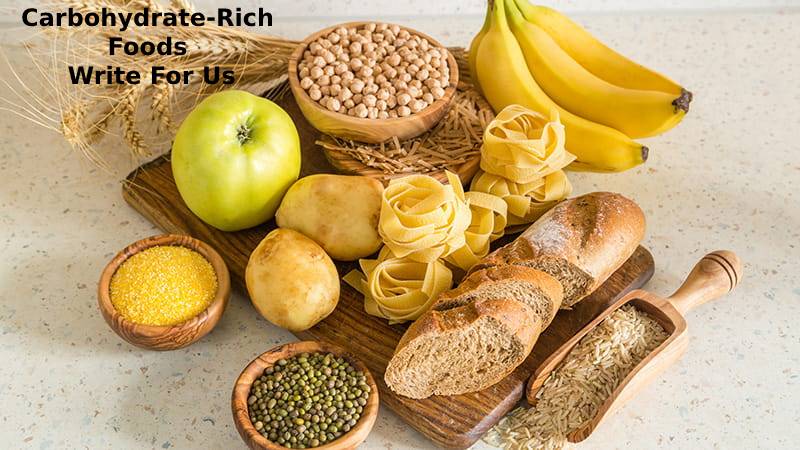Carbohydrate-Rich Foods Write For Us
 Carbohydrate-Rich Foods have gotten a bad rap over the last few decades. But not all carbs are bad for you, and these are just refined carbohydrates you should avoid.
Carbohydrate-Rich Foods have gotten a bad rap over the last few decades. But not all carbs are bad for you, and these are just refined carbohydrates you should avoid.
Many unprocessed carbohydrate foods offer high nutritional value and are essential to you.
Here are some healthy high-carb foods you can Similarly add to your diet.
Similarly There are three primary essential macronutrients: carbohydrates, proteins, and fats.
Fiber is the fourth most crucial ingredient in the diet, which, although not absorbed by the body, plays a pivotal role in preventing many diseases.
Carbs, fiber, and micronutrients (minerals and vitamins) are usually grouped in whole grains, fruits, and root vegetables, healthier options than processed carbs.
What are Carbohydrate-Rich Foods? Why are they essential?
Simply put, carbohydrates are nothing more than the complex starches, simple sugars, and fiber found in vegetables, fruits, grains, and other dairy products. Today’s world may have betrayed their reputation, but they are essential to a healthy life.
They’re macronutrients, meaning they’re one of the three main ways the body gets energy (the other two macronutrients are protein and fat).
And carbs are essential, mind you, and they provide fuel and energy to the central nervous system and working muscles. They prevent protein from being used as a power source and support fat metabolism.
There is a lot of confusion around this topic – Carbohydrate-Rich Foods. Good and bad carbohydrates, and simple and complex Carbohydrate-Rich Foods. We will see all of this a little later. But first, look at high-carb foods and how they can benefit you.
Which are high in Carbohydrate-Rich Foods?
The foods you eat regularly are rich in this important (but overused) nutrient. The richest sources include:
Brown rice
buckwheat
Red beans
lenses
Andean millet
Brown Rice
Brown rice is a rich plant lignan foundation that may protect against heart disease. It is also rich in magnesium, and this mineral also contributes to heart health, as does selenium, another mineral brown rice is rich in. Brown rice may also lower cholesterol and reduce the risk of diabetes.
But it would help if you didn’t overdo it or eat it every day because of the high levels of arsenic found in all types of rice, predominantly brown rice. Rice absorbs arsenic from groundwater more readily than most plants and, like some plant species, is an arsenic accumulator by the highest concentrations in the outermost fibrous part of the plant, which is removed to produce white Carbohydrate-Rich Foods.
Buckwheat
In addition to carbohydrates, buckwheat is also rich in protein, and it contains 12 amino acids that support energy, proper growth, and muscle synthesis. And the fiber content of buckwheat aids digestion and improves digestive health, keeping many digestive problems at bay.
Red Beans
Kidney beans can also reduce the risk of heart disease, and one way to do this is to lower bad cholesterol without sacrificing good cholesterol (2). Kidney beans also contain alpha-amylase inhibitors that prevent the absorption and breakdown of starch, leading to weight loss.
Lenses
Lentils are excellent protein sources; if you’re a vegetarian with higher protein needs, they can be a perfect place to start. They also contain fiber, folic acid, and potassium, nutrients necessary for heart health. And since lentils are a good source of non-heme iron, they also help fight fatigue. They can also be an excellent meat substitute.
Andean Millet
Quinoa is whole grain high in protein, iron, and fiber. Proteins help cells repair and create new ones and can be a good alternative for people with diabetes. And the antioxidants found in quinoa prevent cell damage and help slow aging.
How to Submit Your Articles?
For Submitting Your Articles, you can email us contact@beautymagnetism.com
Why Write For beautymagnetism – Carbohydrate-Rich Foods Write for Us
 Search Related Terms to Carbohydrate-Rich Foods Write for Us
Search Related Terms to Carbohydrate-Rich Foods Write for Us
- healthy carbohydrate foods
- high carb foods to avoid
- low-carb foods
- carbohydrates food list with images
- carbohydrates examples
- high carb diet plan
- high carb vegetables
- healthy carbs for weight loss
- Amadori rearrangement
- Carbohydrate acetalisation
- Carbohydrate digestion
- Cyanohydrin reaction
- high carb foods to avoid
- high carb vegetables
- carbohydrates examples
Search Terms for to Carbohydrate-Rich Foods Write for Us
- submit the post
- contributing writer
- guest posts wanted
- submit an article
- writers wanted
- guest posts wanted
- contributor guidelines
- suggest a post
- guest post
- becomes an author
- become a guest blogger
- looking for guest posts
- guest posting guidelines
- write for us
Guidelines for Article to Writing Carbohydrate-Rich Foods Write for Us
 you can email us contact@beautymagnetism.com
you can email us contact@beautymagnetism.com
Related Pages
Dark Lipstick Lighter write for us
Black Girl Makeup write for us
Cotton Candy Hair Color write for us
Eye Makeup Tutorials write for us
